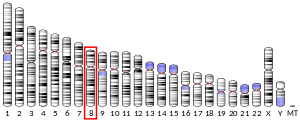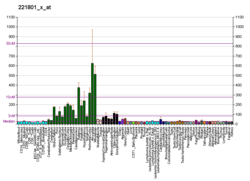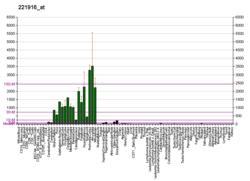Neurofilament light polypeptide
Neurofilament light polypeptide (NFL), also known as neurofilament light chain, is a neurofilament protein that in humans is encoded by the NEFL gene.[5][6] Neurofilament light chain is a biomarker that can be measured with immunoassays in cerebrospinal fluid and plasma and reflects axonal damage in a wide variety of neurological disorders.[7][8] It is a useful marker for disease monitoring in amyotrophic lateral sclerosis,[9] multiple sclerosis,[10] Alzheimer's disease,[11][12] and more recently Huntington's disease.[13]
It is associated with Charcot–Marie–Tooth disease 1F and 2E.[5]
References
- GRCh38: Ensembl release 89: ENSG00000277586 - Ensembl, May 2017
- GRCm38: Ensembl release 89: ENSMUSG00000022055 - Ensembl, May 2017
- "Human PubMed Reference:". National Center for Biotechnology Information, U.S. National Library of Medicine.
- "Mouse PubMed Reference:". National Center for Biotechnology Information, U.S. National Library of Medicine.
- Miltenberger-Miltenyi G, Janecke AR, Wanschitz JV, Timmerman V, Windpassinger C, Auer-Grumbach M, Löscher WN (July 2007). "Clinical and electrophysiological features in Charcot-Marie-Tooth disease with mutations in the NEFL gene". Archives of Neurology. 64 (7): 966–70. doi:10.1001/archneur.64.7.966. PMID 17620486.
- "Entrez Gene: NEFL neurofilament, light polypeptide 68kDa".
- Khalil M, Teunissen CE, Otto M, Piehl F, Sormani MP, Gattringer T, Barro C, Kappos L, Comabella M, Fazekas F, Petzold A, Blennow K, Zetterberg H, Kuhle J (October 2018). "Neurofilaments as biomarkers in neurological disorders" (PDF). Nature Reviews. Neurology. 14 (10): 577–589. doi:10.1038/s41582-018-0058-z. PMID 30171200.
neuroaxonal damage is the pathological substrate of permanent disability in various neurological disorders. ... Here, we review what is known about the structure and function of neurofilaments, discuss analytical aspects and knowledge of age-dependent normal ranges of neurofilaments and provide a comprehensive overview of studies on neurofilament light chain as a marker of axonal injury in different neurological disorders, including multiple sclerosis, neurodegenerative dementia, stroke, traumatic brain injury, amyotrophic lateral sclerosis and Parkinson disease.
- Thompson AB, Mead SH (December 2018). "Review: Fluid biomarkers in the human prion diseases". Molecular and Cellular Neurosciences. 97: 81–92. doi:10.1016/j.mcn.2018.12.003. PMID 30529227.
The very rapid neurodegeneration of prion disease results in strong signals from surrogate protein markers in the blood that reflect neuronal, axonal, synaptic or glial pathology in the brain: notably the tau and neurofilament light chain proteins.
- Xu Z, Henderson RD, David M, McCombe PA (2016). "Neurofilaments as Biomarkers for Amyotrophic Lateral Sclerosis: A Systematic Review and Meta-Analysis". PLOS ONE. 11 (10): e0164625. doi:10.1371/journal.pone.0164625. PMC 5061412. PMID 27732645.
NF heavy and light chain levels have potential use as a marker of neural degeneration in ALS, but are not specific for the disease, and are more likely to be used as measures of disease progression.
- Cai L, Huang J (2018). "Neurofilament light chain as a biological marker for multiple sclerosis: a meta-analysis study". Neuropsychiatric Disease and Treatment. 14: 2241–2254. doi:10.2147/NDT.S173280. PMC 6126505. PMID 30214214.
NFL chain has significantly increased in MS patients, which substantially strengthens the clinical evidence of the NFL in MS. The NFL may be used as a prognostic biomarker to monitor disease progression, disease activity, and treatment efficacy in the future.
- Zetterberg, Henrik (6 February 2019). "Biomarkers for Alzheimer's disease beyond amyloid and tau". Nature Medicine. 25 (2): 201–203. doi:10.1038/s41591-019-0348-z. PMID 30728536.
- Preische O, Schultz SA, Apel A, et al. (2019). "Serum neurofilament dynamics predicts neurodegeneration and clinical progression in presymptomatic Alzheimer's disease". Nature Medicine. 25 (2): 277–283. doi:10.1038/s41591-018-0304-3. PMC 6367005. PMID 30664784.
- Niemelä V, Landtblom AM, Blennow K, Sundblom J (27 February 2017). "Tau or neurofilament light-Which is the more suitable biomarker for Huntington's disease?". PLOS ONE. 12 (2): e0172762. doi:10.1371/journal.pone.0172762. PMC 5328385. PMID 28241046.
- Frappier T, Stetzkowski-Marden F, Pradel LA (April 1991). "Interaction domains of neurofilament light chain and brain spectrin". The Biochemical Journal. 275 ( Pt 2) (2): 521–7. doi:10.1042/bj2750521. PMC 1150082. PMID 1902666.
- Mukai H, Toshimori M, Shibata H, Kitagawa M, Shimakawa M, Miyahara M, Sunakawa H, Ono Y (April 1996). "PKN associates and phosphorylates the head-rod domain of neurofilament protein". The Journal of Biological Chemistry. 271 (16): 9816–22. doi:10.1074/jbc.271.16.9816. PMID 8621664.
- Haddad LA, Smith N, Bowser M, Niida Y, Murthy V, Gonzalez-Agosti C, Ramesh V (November 2002). "The TSC1 tumor suppressor hamartin interacts with neurofilament-L and possibly functions as a novel integrator of the neuronal cytoskeleton". The Journal of Biological Chemistry. 277 (46): 44180–6. doi:10.1074/jbc.M207211200. PMID 12226091.
Further reading
- Hirokawa N, Takeda S (October 1998). "Gene targeting studies begin to reveal the function of neurofilament proteins". The Journal of Cell Biology. 143 (1): 1–4. doi:10.1083/jcb.143.1.1. PMC 2132816. PMID 9763415.
- Beaudet L, Charron G, Julien JP (May 1992). "Origin of the two mRNA species for the human neurofilament light gene". Biochemistry and Cell Biology. 70 (5): 279–84. doi:10.1139/o92-044. PMID 1497855.
- Frappier T, Stetzkowski-Marden F, Pradel LA (April 1991). "Interaction domains of neurofilament light chain and brain spectrin". The Biochemical Journal. 275 ( Pt 2) (Pt 2): 521–7. doi:10.1042/bj2750521. PMC 1150082. PMID 1902666.
- Chin SS, Liem RK (December 1989). "Expression of rat neurofilament proteins NF-L and NF-M in transfected non-neuronal cells". European Journal of Cell Biology. 50 (2): 475–90. PMID 2516804.
- Julien JP, Grosveld F, Yazdanbaksh K, Flavell D, Meijer D, Mushynski W (June 1987). "The structure of a human neurofilament gene (NF-L): a unique exon-intron organization in the intermediate filament gene family". Biochimica et Biophysica Acta. 909 (1): 10–20. doi:10.1016/0167-4781(87)90041-8. PMID 3034332.
- Hurst J, Flavell D, Julien JP, Meijer D, Mushynski W, Grosveld F (1987). "The human neurofilament gene (NEFL) is located on the short arm of chromosome 8". Cytogenetics and Cell Genetics. 45 (1): 30–2. doi:10.1159/000132421. hdl:1765/2414. PMID 3036423.
- Frappier T, Regnouf F, Pradel LA (December 1987). "Binding of brain spectrin to the 70-kDa neurofilament subunit protein". European Journal of Biochemistry. 169 (3): 651–7. doi:10.1111/j.1432-1033.1987.tb13657.x. PMID 3121319.
- Nomata Y, Watanabe T, Wada H (March 1983). "Highly acidic proteins from human brain: purification and properties of Glu-50 protein". Journal of Biochemistry. 93 (3): 825–31. doi:10.1093/jb/93.3.825. PMID 6135695.
- Maruyama K, Sugano S (January 1994). "Oligo-capping: a simple method to replace the cap structure of eukaryotic mRNAs with oligoribonucleotides". Gene. 138 (1–2): 171–4. doi:10.1016/0378-1119(94)90802-8. PMID 8125298.
- Pospelov VA, Pospelova TV, Julien JP (February 1994). "AP-1 and Krox-24 transcription factors activate the neurofilament light gene promoter in P19 embryonal carcinoma cells". Cell Growth & Differentiation. 5 (2): 187–96. PMID 8180132.
- Dong DL, Xu ZS, Chevrier MR, Cotter RJ, Cleveland DW, Hart GW (August 1993). "Glycosylation of mammalian neurofilaments. Localization of multiple O-linked N-acetylglucosamine moieties on neurofilament polypeptides L and M". The Journal of Biological Chemistry. 268 (22): 16679–87. PMID 8344946.
- Charron G, Guy LG, Bazinet M, Julien JP (December 1995). "Multiple neuron-specific enhancers in the gene coding for the human neurofilament light chain". The Journal of Biological Chemistry. 270 (51): 30604–10. doi:10.1074/jbc.270.51.30604. PMID 8530496.
- Mukai H, Toshimori M, Shibata H, Kitagawa M, Shimakawa M, Miyahara M, Sunakawa H, Ono Y (April 1996). "PKN associates and phosphorylates the head-rod domain of neurofilament protein". The Journal of Biological Chemistry. 271 (16): 9816–22. doi:10.1074/jbc.271.16.9816. PMID 8621664.
- Rosengren LE, Karlsson JE, Karlsson JO, Persson LI, Wikkelsø C (November 1996). "Patients with amyotrophic lateral sclerosis and other neurodegenerative diseases have increased levels of neurofilament protein in CSF". Journal of Neurochemistry. 67 (5): 2013–8. doi:10.1046/j.1471-4159.1996.67052013.x. PMID 8863508.
- Suzuki Y, Yoshitomo-Nakagawa K, Maruyama K, Suyama A, Sugano S (October 1997). "Construction and characterization of a full length-enriched and a 5'-end-enriched cDNA library". Gene. 200 (1–2): 149–56. doi:10.1016/S0378-1119(97)00411-3. PMID 9373149.
- Athlan ES, Mushynski WE (December 1997). "Heterodimeric associations between neuronal intermediate filament proteins". The Journal of Biological Chemistry. 272 (49): 31073–8. doi:10.1074/jbc.272.49.31073. PMID 9388258.
- Ehlers MD, Fung ET, O'Brien RJ, Huganir RL (January 1998). "Splice variant-specific interaction of the NMDA receptor subunit NR1 with neuronal intermediate filaments". The Journal of Neuroscience. 18 (2): 720–30. doi:10.1523/JNEUROSCI.18-02-00720.1998. PMC 6792537. PMID 9425014.
- Mersiyanova IV, Perepelov AV, Polyakov AV, Sitnikov VF, Dadali EL, Oparin RB, Petrin AN, Evgrafov OV (July 2000). "A new variant of Charcot-Marie-Tooth disease type 2 is probably the result of a mutation in the neurofilament-light gene". American Journal of Human Genetics. 67 (1): 37–46. doi:10.1086/302962. PMC 1287099. PMID 10841809.
- De Jonghe P, Mersivanova I, Nelis E, Del Favero J, Martin JJ, Van Broeckhoven C, Evgrafov O, Timmerman V (February 2001). "Further evidence that neurofilament light chain gene mutations can cause Charcot-Marie-Tooth disease type 2E". Annals of Neurology. 49 (2): 245–9. doi:10.1002/1531-8249(20010201)49:2<245::AID-ANA45>3.0.CO;2-A. PMID 11220745.
External links
- Bird TD (26 March 2015). "Charcot-Marie-Tooth Neuropathy Type 1". In Pagon RA, Bird TD, Dolan CR, et al. (eds.). GeneReviews™ [Internet]. Seattle WA: University of Washington, Seattle. NBK1205.
- Bird TD (30 January 2014). Charcot-Marie-Tooth Neuropathy Type 2. PMID 20301462. NBK1285. In GeneReviews
- De Jonghe P, Jordanova AK (2011-10-27). Charcot-Marie-Tooth Neuropathy Type 2E/1F. NBK1187. In GeneReviews
This article is issued from
Wikipedia.
The text is licensed under Creative
Commons - Attribution - Sharealike.
Additional terms may apply for the media files.






